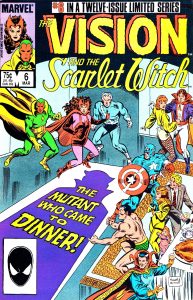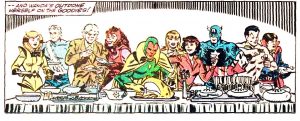 Actually, the story, published in issue #6 of 1985’s Vision and the Scarlet Witch maxi-series, is called “No Strings Attached.”
Actually, the story, published in issue #6 of 1985’s Vision and the Scarlet Witch maxi-series, is called “No Strings Attached.”
These were the days when Marvel Comics were consistently fun. Possibly the last of those days, as the onslaught of the 90s (Get it? Onslaught? Heh.) turned the Marvel Universe into a place of doom and gloom and dark despair. And epaulets. Jackets with epaulets. Yeah. ‘Cause that’s what super-heroes are about.
If you want to find comics that capture the spirit of fun and optimism that you find when you go to see a Marvel Studios movie, your best bet is to go pre-1987. That’s not to say that there aren’t some dark times for our heroes during those runs—the death of Gwen Stacy, the Secret Empire, the Dark Phoenix Saga—all angst-ridden and brooding, yes. But still the ultimate feel was fun and light and triumph.
Never was that sense more obvious, for me, than in Steve Englehart and Richard Howell’s 12-issue celebration of the successful marriage of human and android, mutant and non-mutant, science and sorcery, that was Vision and the Scarlet Witch. The whole series was pretty much a super-hero sitcom, with each issue encompassing the important events of one month in the lives of this unique couple, all leading up to the births of their twin sons, Billy and Tommy, now known as Wiccan and Speed of the Young Avengers.
Issue #6 was set in November, and was thus the Thanksgiving issue. Wanda, an orphan, and Vision, an artificial man with the brain patterns of another human, didn’t have a lot of family except each other when they first married back in 1975 (In Giant-Size Avengers #4). Wanda had, at that time, recently learned that Bob Frank, the Golden Age hero called The Whizzer, was her father. The Vision’s dad, though, was the murderous robot Ultron. As of 1983, The Whizzer was dead, and had been revealed not to be Wanda’s father. Ultron was, well, Ultron. For Wanda and Vizh, “family” meant only “The Avengers.”
In this series, however, that changed. The Vision embraced the human personality that he had inherited from Simon Williams, Wonder Man. And Simon’s mother, Martha, had happily adopted Vision as another son. (Martha. Good name for a super-hero mother. I bet Vizh and Simon could have added a little levity and credibility to Batman V. Superman.)
And Wanda? Well, she had reconnected with her brother Pietro, who had married the Inhuman Crystal and had a daughter, Luna. And, in the previous, Bill Mantlo-scripted Vision and Witch mini-series, they had learned that their real father was, in fact, Magneto, once master of the Brotherhood of Evil Mutants, now headmaster of Xavier’s School for Gifted Youngsters, the training academy for the X-Men.
So Thanksgiving in the Vision/Witch house meant quite a few guests: The Avengers, of course, Wanda’s OB/GYN, Stephen Strange, their Realtor, Norm Webster, their next door neighbors, magicians Glamour and Illusion, Quicksilver, Crystal, Luna, Martha Williams (Simon was in California with the West Coast Avengers, and they were on a case), and… Wanda’s father.
 “I told everyone else about the baby,” she explains to her brother. “Eventually I couldn’t put it off anymore. And when I called him—it was so close to Thanksgiving, I couldn’t not invite him.”
“I told everyone else about the baby,” she explains to her brother. “Eventually I couldn’t put it off anymore. And when I called him—it was so close to Thanksgiving, I couldn’t not invite him.”
So Magneto shows up, looking like, well, a grandfather in a brown suede jacket and ugly sweater. He can tell he’s not welcome, and, after exchanging a few pleasantries, he asks to speak to Wanda alone. She explains that she wants him to know his grandchildren, but that she can’t forgive his enslaving his own children when they were younger.
So Magneto leaves, only to be confronted by the Brotherhood of Evil Mutants. Well, not the real Brotherhood, since it includes duplicates of both himself and his son Pietro. Magneto quietly taps his son and son-in-law to leave the festivities and help him handle the bogus Brotherhood. He insists that Wanda’s first normal Thanksgiving with a family not be ruined. The men of the family battle the duplicates and learn that they were created by Magneto’s old toady, the Toad, who now calls himself The Terrible Toad King, and who thinks his artificial Brotherhood will help him win Wanda for himself.
So Pietro disguises himself as his double, in his old green uniform, and conks out their diminutive Lothario. It really does feel like a TV Thanksgiving special, with the usual family drama thrown in, and the usual nice character moments. I think my favorite is Captain America’s realization that, with Namor and the Vision beside him, he’s in the presence—physically, anyway, of the original Invaders from World War II. Vision says that he regrets that he has none of the Original Human Torch’s memories, but also reflects privately that it’s an interesting thought.
Where Englehart was going to take that interesting thought was lost when he was removed from the writing of The West Coast Avengers and replaced by John Byrne. Byrne disassembled the Vision, destroyed his children and erased his memories, effectively rendering this series null and void. He also rewrote the history that had Vision’s body being that of the Original Human Torch.
It’s too bad, because, as I said at the beginning, this series was fun. And, until their incarnation in the movies, very little that’s been done with the android and the mutant sorceress has been fun, however interesting the stories have been.
